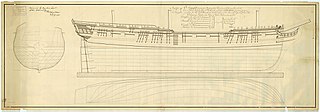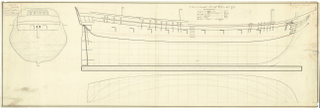Career
Lieutenant John Wyatt commissioned Tigress in November 1797. Lieutenant William H.B.Tremlett took command in 1800.
She was part of the North Sea Fleet and so participated in the head money for the Battle of Copenhagen in 1801. [2] Admiral Lord Nelson, in letter, remarked on "with the exception of the glaring misconduct of the Officers of the Tigress and Cracker gun brigs". [3] Unfortunately it is not clear what the glaring misconduct was.
In 1801 Lieutenant William Davies took command of Tigress in the Baltic.
On 20 and 21 August HMS Jamaica 's boats and several vessels were involved in action in the neighbourhood of Étaples. On the evening of 20 August Jamaica was off Etaples when she heard cannon fire and lookouts saw a large fire. Captain Jonas Rose sailed to investigate, encountering Hound, which informed him that the fire came from a cargo of pitch and tar on a vessel wrecked on the coast some time previously that boats from Hound and Mallard had set on fire. Six flat boats had come out of Saint Valery but Hound had forced them onshore, where they still lay. The following morning Rose sent in boats from Jamaica, the brig sloops Hound and Gannet, and the gunbrigs Mallard and Tygress. As the boats went in the ships themselves provide covering fire. The boats brought out two launches and a flat boat 45' long and 24' wide, armed with an 8" howitzer. However, the latter later sank; the other three on shore had already been so damaged that they were irretrievable, but the landing party still did as much further damage as time permitted. Tigress lost one man slightly wounded. [4]
Disposal: "The Principal Officers and Commissioners of His Majesty's Navy" offered "Tigress, Gun Vessel 168 tons, lying at Sheerness" for sale on 20 January 1802. [5] She was sold in January.

HMS Galatea was a fifth-rate 32-gun sailing frigate of the British Royal Navy that George Parsons built at Bursledon and launched in 1794. Before she was broken up in 1809 she captured numerous prizes and participated in a number of actions, first in the Channel and off Ireland (1794–1803), and then in the Caribbean (1802–1809), including one that earned her crew the Naval General Service Medal.

HMS Babet was a 20-gun sixth-rate post ship of the British Royal Navy. She had previously been a corvette of the French Navy under the name Babet, until her capture in 1794, during the French Revolutionary Wars. She served with the British, capturing several privateers and other vessels, and was at the Battle of Groix. She disappeared in the Caribbean in 1800, presumably having foundered.
Launched on 21 May 1797, GB No. 21 was renamed HMS Defender on 7 August the same year. She was a 12-gun Courser-class gun-brig built for the British Royal Navy at Limehouse and disposed of in 1802.

HMS Mercury was a 28-gun Enterprise-class sixth-rate frigate of the Royal Navy. She was built during the American War of Independence and serving during the later years of that conflict. She continued to serve during the years of peace and had an active career during the French Revolutionary Wars and most of the Napoleonic Wars, until being broken up in 1814.

HMS Unicorn was a 32-gun fifth-rate Pallas-class frigate of the Royal Navy, launched in 1794 at Chatham. This frigate served in both the French Revolutionary Wars and the Napoleonic Wars, including a medal action early in her career. She was broken up in 1815.
HMS Tigress was the American merchantman Numa and then French letter of marque Pierre Cézar that the Royal Navy acquired by capture and put into service as the gunbrig Tigress. She spent some time on the West African coast in the suppression of the slave trade. The Admiralty later renamed her as Algerine. She was broken up in 1818.
HMS Bold was a 14-gun Archer-class gun-brig of the Royal Navy built at Blackwall Yard. She took part in several minor actions and captured some prizes before she grounded in 1811 and was broken up shortly thereafter.
HMS Atalante was a 16-gun brig-sloop of the Royal Navy. She was formerly the French Atalante, captured in 1797. She served with the British during the French Revolutionary and Napoleonic Wars, and was wrecked in 1807.

HMS Hornet was a 16-gun ship-rigged sloop of the Cormorant class in the Royal Navy, ordered 18 February 1793, built by Marmaduke Stalkart and launched 3 February 1794 at Rotherhithe. Hornet saw most of her active duty during the French Revolutionary Wars. During the Napoleonic Wars she served for about six years as a hospital ship before being laid up in 1811 and sold in 1817.
HMS Sandfly was a Musquito-class floating battery of the Royal Navy. The two-vessel class was intended to defend the Îles Saint-Marcouf (Marcou) situated off the Normandy coast. During her brief career Sandfly shared in the capture of one privateer and participated in a battle that would earn her crew the Naval General Service Medal. The Peace of Amiens returned the islets to France in May 1802; Sandfly was paid off in June 1802 and broken up in 1803.
HMS Port Royal was a 10-gun schooner that the British Royal Navy bought in Jamaica in 1796. The French captured her in 1797 and the British recaptured her later that year, when they renamed her HMS Recovery. She captured three privateers, one in a single-ship action, before the Navy sold her in 1801.

HMS Kangaroo was British Royal Navy 18-gun brig-sloop of the Diligence class, launched in 1795 at Rotherhithe, England. She served in Home Waters and the Mediterranean Sea until she was sold in 1802.
Mutin was a 14-gun cutter of the French Navy, the lead ship of the Mutin class of five naval cutters. She was launched in 1778 and the Royal Navy captured her the next year, taking her into service as HMS Mutine. The Royal Navy renamed her HMS Pigmy in 1798. She was lost in 1805.
Perçante was a 20-gun ship-corvette of the French Navy, built at Bayonne and launched in 1795. The British captured her in 1796 and took her into the Royal Navy under the name HMS Jamaica. They rated her as a sixth-rate 26-gun frigate. She served during both the French Revolutionary Wars and part of the Napoleonic Wars, during which she captured some privateers and participated in a boat attack. The Admiralty had her laid up in 1810 and sold her in 1814.
HMS Renard was the French privateer Renard, launched in 1797, that Cerberus captured in the Channel that same year. The Royal Navy took her into service under her existing name and she participated in some notable engagements on the Jamaica station before the Navy sold her in 1809.

The French gun-vessel Eclair was one of 20 chasse-marées built in 1785 in southern Brittany for use as service craft in harbour construction at Cherbourg. In 1793 Martin or Jacques Fabien converted ten of them into chaloupes-canonnières (gun-vessels). One of these received the name Eclair. Sir Richard Strachan's squadron captured her in 1795 in Cartaret Bay, and the Royal Navy took her into service as HMS Eclair. She then sailed to the West Indies where she was probably out of service by 1801. In 1802 she was hulked under the name HMS Safety. She then served as a prison ship at Jamaica around 1808 to 1810. She may have been sold at Tortola in 1817/18, but in 1841 or so was brought back into service there as a receiving hulk. She was broken up in 1879.

HMS Woolwich was an Adventure-class frigate launched in 1784. She essentially spent her career as a storeship until she was wrecked in 1813.

HMS Barbuda was commissioned into the Royal Navy in 1780 after having briefly served as an American privateer. Barbuda was one of the two sloops that captured Demerara and Essequibo in 1781, but the French Navy captured her there in 1782 and took her into service as Barboude. The French Navy sold her to private owners in 1786, and she served briefly as a privateer in early 1793 before the French Navy purchased her again and named her Légère. She served them until mid-1796 when the Royal Navy captured her and took her into service as HMS Legere. She was wrecked off the coast of Colombia, without loss of life, in February 1801.
Adèle was a French privateer brig commissioned in 1800 that the British Royal Navy captured later that year. The British East India Company's government in India purchased her in 1801 for service as an armed brig in the Bay of Bengal and along the Coromandel Coast. In 1804 she sailed to Britain where the Admiralty purchased her for use as a fire ship, and named her HMS Firebrand. She was wrecked in 1804.
HMS Cracker was an Acute-class gunbrig, launched in 1797. She was sold in 1802.








